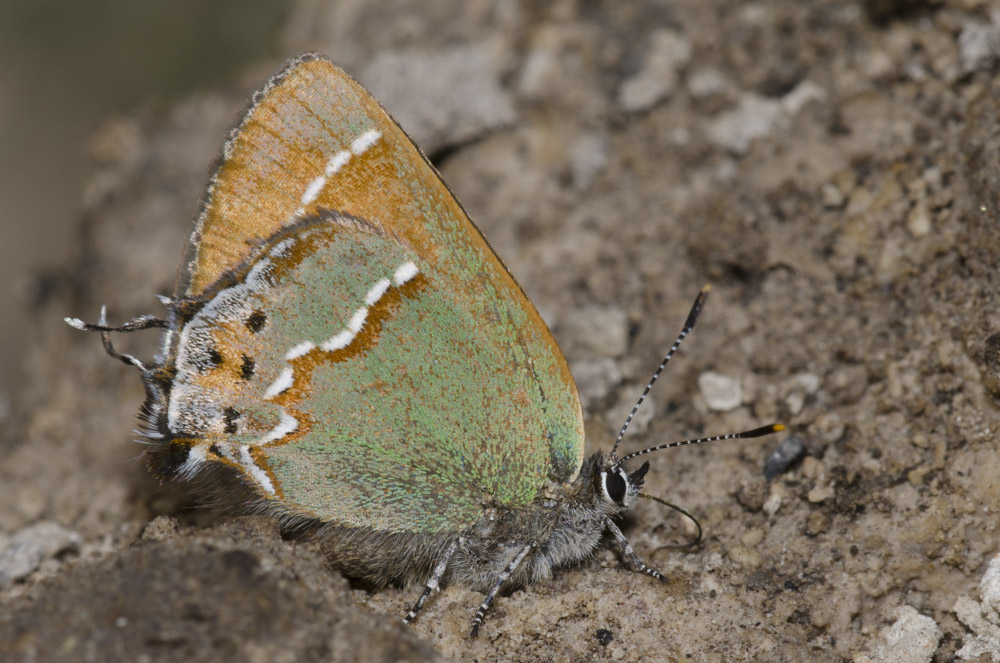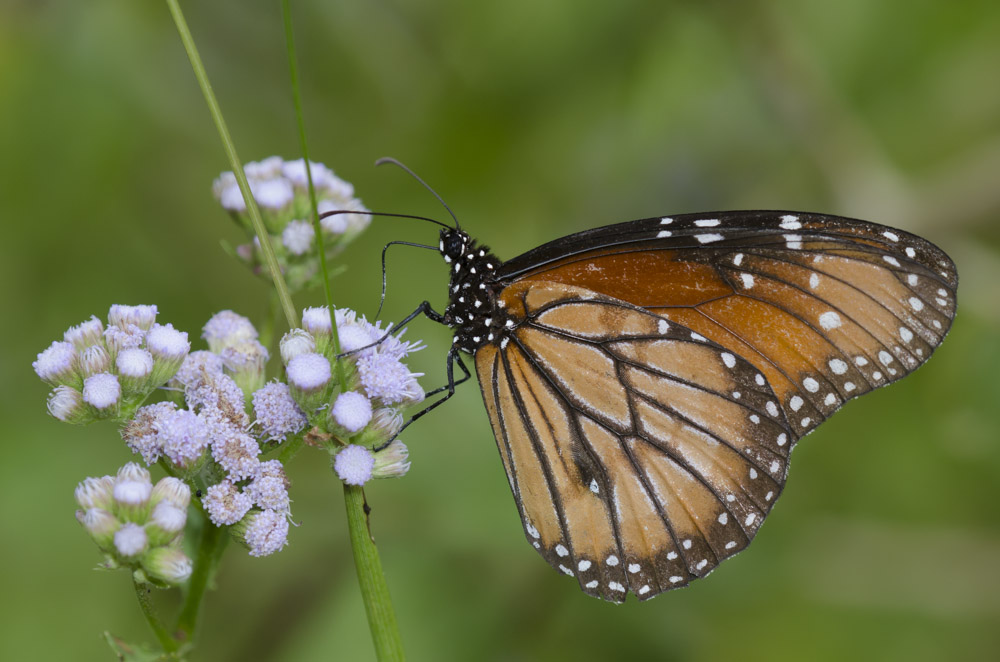Oklahoma’s impressive butterfly fauna of more than 170 species includes the nation’s largest and the smallest, and representatives of all six major butterfly families.
This piece originally appeared in the Spring 2018 edition of Xerces’ biannual publication Wings. Click to view the full Spring 2018 issue.
I grew up near the foothills of the Appalachian Mountains, amid tall forests of beech, maple, and oak. If you had asked me back then to describe Oklahoma, I would have guessed that it was flat, brown, and dusty. (Cincinnati was the farthest west I traveled in those days.) Now that I’ve lived here for fourteen years, I know how wrong I was. Much of the state is hilly—some areas are downright mountainous—and most of the state is verdant during spring, summer, and early fall. Rather than being full of dust, Oklahoma skies are often full of butterflies. Of the twenty-seven states I’ve visited or lived in, this is one of the best for butterfly watching, blessed with a great diversity and a particularly high abundance.
Oklahoma’s impressive butterfly fauna of more than 170 species includes the nation’s largest (the giant swallowtail) and the smallest (the western pygmy blue), and representatives of all six major butterfly families: Papilionidae (swallowtails), Pieridae (whites and sulphurs), Lycaenidae (gossamerwings), Hesperiidae (skippers), Riodinidae (metalmarks), and Nymphalidae (brush-foots). Such variety is primarily a result of the state’s range of ecosystems and vegetation types—from the shortgrass prairie of the Panhandle in the northwest corner of the state to the towering forests of shortleaf pines that drape the Ouachita Mountains in the southeast. In addition, Oklahoma’s geographic position near the center of the lower forty-eight brings us butterfly species from most regions of the country—the Northeast, the Southeast, and the Southwest, as well as the Rocky Mountains— to complement those that are most at home in Oklahoma’s climate, which is sunny and warm much of the year and conducive to supporting populations of many butterfly species. We even get the occasional subtropical butterfly from southern Texas and northern Mexico. In 2006, one of these, the common mestra (Mestra amymone), showed up in my Stillwater backyard, quite an unexpected treat!
Eight swallowtail species have been recorded in Oklahoma, including our state butterfly, the black swallowtail (Papilio polyxenes). We have four widespread species (black, tiger, giant, and pipevine), two that are limited to the eastern forests (spicebush and zebra), and two vagrants (two-tailed and Thoas).
At least twenty-two species in the family Pieridae occur in Oklahoma. Three of the most widespread are the orange sulphur, the dainty sulphur, and the checkered white. But sleepy oranges and little yellows come to my garden each year to lay eggs on wild senna, and the large and brightly colored cloudless sulphur shows up each year to lay eggs on partridge pea. Cloudless sulphurs are very strong flyers, and exhibit a significant southward migration each fall.
The blues, coppers, and hairstreaks of the gossamer-wing family (Lycaenidae) tend to be small, but they often have striking colors—iridescent blues, greens, or coppery oranges—and intricate color patterns. Most of the hairstreaks lay eggs on oak trees and most of the blues lay on legumes, particularly lupines, but host plants also include dock for gray coppers and bronze coppers, and eastern red cedar for juniper hairstreaks. In addition to the United States’ smallest butterfly, the western pygmy blue, this family includes the country’s only carnivorous one, the harvester (Feniseca tarquinius), whose caterpillar host “plants” are woolly aphids!

The most species-rich butterfly family in Oklahoma is the Hesperiidae (skippers), with nearly seventy species. The majority of them are tiny, barely larger than your thumbnail, and extremely quick, flitting from flower to flower to flower in a second or two. They can be very difficult to identify. I once watched two butterfly experts debate the identity of a skipper that was kind enough to stay perched on a flower twelve inches from their faces. After half an hour, they still weren’t sure what it was.
In contrast, we have only three species of metalmarks (Riodinidae): the little metalmark (Calephelis virginiensis), the northern metalmark (C. borealis), and the swamp metalmark (C. muticum). All are restricted to the eastern edge of the state.
The brush-footed butterfly family (Nymphalidae) is loaded with big, brightly colored species. Painted ladies (Vanessa cardui) and American ladies (V. virginiensis) can be found in great abundance, particularly during migration. Oklahoma is far enough south for us to be blessed with rare visits from zebra longwings (Heliconius charithonia) and julias (Dryas iulia), tropical species that lay their eggs on passionflower. Our passionflowers, though, are most often fed upon by larvae of another longwing, the gulf fritillary (Agraulis vanillae). Any garden in Oklahoma that has healthy, native passionflower vines is likely to host gulf fritillaries and, last summer and fall, my two vines helped to feed hundreds of their larvae.
The family Nymphalidae includes what is likely the most popular butterfly genus, Danaus, the milkweed butterflies: the monarch (D. plexippus) and two close relatives, the queen (D. gilippus), which typically breeds in scattered locations across the state, and the soldier (D. eresimus), a few of which have wandered up from the subtropical climes of south Texas. We have monarchs in abundance every year, although old-timers have told me that they used to see many, many more when they were young. Oklahoma and other southern states are where monarchs returning from their winter sojourn in the mountains of central Mexico first arrive in spring to search for milkweeds, lay eggs, and die. By June, monarchs move northward and become sparse here. They show up again in August, and breed prolifically again where milkweed is available to produce a “fifth” generation. For a few weeks beginning in late September, Oklahoma becomes one of the most exciting places for a monarch watcher to be, as waves of millions of monarchs pour through from the Northern Plains, the Midwest, and the Great Lakes.

But, for me, the most fascinating butterflies are the fritillaries of the genus Speyeria. These large, showy brush-foots are among the most beautiful butterflies in North America—many have shining silver spots on their underwings—and perhaps no other genus demonstrates the advantage of our central location, even though only four species have been recorded in the state. The great spangled fritillary (S. cybele) occurs from coast to coast in the United States, but Oklahoma is about as far south as it is found. Edwards’ fritillary (S. edwardsii), is a species of the Rocky Mountain states that has been recorded in the far western Panhandle. The other side of Oklahoma lies on the western frontier of two eastern species, the Diana fritillary (S. diana) and the regal fritillary (S. idalia).
Adult Diana fritillaries are colossal (although not as large as giant swallowtails), and they exhibit striking sexual dimorphism: the males are brilliant orange and brown, whereas the females are metallic blue and black. Regal fritillaries are also special—orange and purplish-blue above, while the undersides of the wings are orange and copper punctuated by bright white spots. Certainly deserving of the name “regal!”
The Diana and regal have intriguing natural histories. Like many fritillaries, both require violets as their host plants, but these two differ greatly in their habitat requirements. Dianas occupy moist woodlands and forests, and those within Oklahoma are thus restricted to the tree-covered Ozark and Ouachita mountains, in the eastern part of the state—or at least so we thought.
One surprising development in the last decade is the appearance of Dianas west of these mountain ranges, first in the Tulsa metro area, but later at the edge of the Flint Hills in Osage County, and even on occasion in central Oklahoma. Unlike the Diana, the regal fritillary is a true grassland specialist and, unfortunately, it is in trouble. Once found in thirty-two states, it has been extirpated from fourteen and is secure in only a handful. Famed lepidopterist Lincoln Brower once told me that he chased after regal fritillaries during his boyhood in New Jersey. Sadly, today’s New Jerseyans cannot replicate that experience.
The main cause of the regal fritillary’s decline is loss of grasslands, due to urban development, conversion to agriculture, or succession to forest. In Oklahoma, the regal fritillary is critically imperiled, and in the last five years it has been recorded in just a couple of counties in the northeastern part of the state. It appears that the Nature Conservancy’s Tallgrass Prairie Preserve in Osage County is the best place to find them, and that is where they first enchanted me. In 2004, during my first summer in Oklahoma, I was conducting plant community research at this forty-thousand-acre preserve, when I saw a beautiful butterfly zoom by. That was my first regal, and I was so impressed with it that I decided to conduct research on that species for my PhD. Eventually, I followed regals to research sites in Missouri, Kansas, and Iowa; I’ve never tired of hiking through shade-free prairies on hot summer days to see them.
One critical issue is the effect of grassland management on regal fritillary populations. Multiple earlier studies had indicated that the prescribed fires commonly set to kill young trees that try to invade prairie country likely also kill the fritillaries’ immature stages. Although my research did not address that question directly, I found that adult regal fritillaries were more abundant in areas that had been recently burned, and that this was likely due to the stimulative effects of fire on the blooming of nectar-rich native wildflowers—pale purple coneflower, butterfly milkweed, prairie blazing star, and others—on which adult regals love to feed. Alternatives to burning include haying, mowing, and grazing, each of which have different effects on the grassland structure and suitability for regal fritillaries.
Given the impact that management has on regals in their different life stages, care must be taken not to treat an entire site in a single year and to extend the rotation over a long period—in the case of fire, five or more years between burns.
There is a great need to identify the habitat that remains for regal fritillaries, to preserve it, and to figure out what other circumstances are contributing to the declines in abundance. Without a concerted effort, the state is likely to become the fifteenth from which the butterfly has disappeared.
Despite the threats that many species face, butterfly watching in Oklahoma is still superb, and if you’ve never been, I urge you to come. A good time to visit is in June, for the emergence of the Diana and regal fritillaries. Another is during the first half of October, when strong winds from the south (which are common) cause populations of migratory butterflies to build up and you have a good chance of seeing huge numbers of monarchs, as well as sulphurs, skippers, common buckeyes, and gulf fritillaries, before the southerlies die away, releasing the migrants to continue their journeys. For me, the peak of fall butterfly migration in Oklahoma is a source of bliss, annually renewed.
Further Reading
This piece originally appeared in the Xerces Society publication Wings. Read the full spring 2018 issue.
Learn more about the Xerces Society’s Pollinator Conservation Program.




